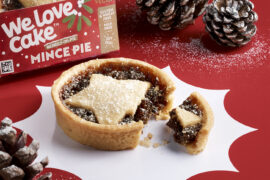Even though cold and dry weather conditions in Morocco during February delayed the start of the strawberry-growing season for the frozen market, Dirafrost NV anticipates that quantities not realized early in the campaign will be made up. As such, the Herk-de-Stad, Belgium-headquartered red fruit specialist, a member of the Austrian Agrana Group, has targeted production of 12,000 tons by the end of June.
 Here’s a view of “Strawberry Fields Forever in Morocco.” While the 2014 season to off to a slow start, Dirafrost anticipates the crop yield will match last year’s volume. The vertically integrated company is able to control the complete supply chain from sowing through harvest, to value-added processing and ultimate delivery to the end user.
Here’s a view of “Strawberry Fields Forever in Morocco.” While the 2014 season to off to a slow start, Dirafrost anticipates the crop yield will match last year’s volume. The vertically integrated company is able to control the complete supply chain from sowing through harvest, to value-added processing and ultimate delivery to the end user.
The company’s factory in Morocco will more than be able to handle the volume, as the installation of a new freezing line has boosted capacity by 30%. Expectations for this season in terms of yield are at the same level of 2013, but raw material prices are reportedly higher than a year ago.
The Agrana Fruit Division sells 450,000 tons of fruit preparations per annum to industrial further processors, retail chains, foodservice operators, bakers and dessert makers who use them for filling, toppings and other applications. Revenues last year amounted to approximately 700 million euro.
Meanwhile, on the dessert menu trends front, Liesbeth Buffels of Dirafrost’s marketing and communications department has spotlighted three areas in which berries are gaining higher profile, as follows:
Seasonal Desserts
According to menu research from Datassential, during the last four years there has been an increasing presence of berries on dessert menus. In the USA, blueberry cakes and tarts are often paired with a touch of lemon as a light way to end a meal. Even less conventional combinations such as blueberry-mango are increasingly offered, as are blueberries in a salad with watercress.
 Seasonal desserts and Fruit Flavor Duos such as these Meringue Bavarian Cream Red Fruit Shooters are among recent trends increasingly spotted on dessert menus at restaurants.
Seasonal desserts and Fruit Flavor Duos such as these Meringue Bavarian Cream Red Fruit Shooters are among recent trends increasingly spotted on dessert menus at restaurants.
In Europe, the demand for wild berries is growing, as they are in line with the desire of many consumers for nutritionally balanced but tasty baked goods. The wild blueberry trend fits in with the flavor trends predicted by Innova at the end of 2013. Indeed, the more sour and stronger berry varieties such as elderberry, sour cherry and blackberry score well.
Bite-size Desserts
Mini-desserts are a way for consumers to keep their sugar and calorie intake under control and to indulge without guilt. Moreover, desserts are no longer limited to the final course of the evening meal. They have become a popular treat to eat any time of the day. As the number of snacking occasions increases, so do occasions for enjoying bite-size desserts.
Research shows that only about half of post-restaurant meal desserts are purchased and consumed at the same place where starters, entrée and other courses are taken. The other half is eaten at home or in a second foodservice establishment.
Healthful, portable mini-desserts offer promising perspectives, as research of Technomic Associates shows that 50% of snack consumers indicate that healthfulness is very important to them when choosing a snack.
Fruit Flavor Duos
Innovating with food is all about trying new combination. Rhubarb-strawberry has been popular for some time, and now juice manufacturers are experimenting with rhubarb-apple. Indeed, rhubarb is being revalued as a fruit that is a bit tangy and also has the appeal of local authenticity. As a cheaper raw material than strawberries, it can be both an economic and tasty choice to combine both fruits in recipes.
Also spotted on more menus on both side of the Atlantic are the combination of blueberry-apple and blueberry-mango.





